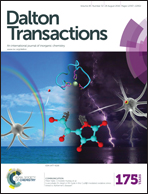Formation and decomplexation kinetics of copper(ii) complexes with cyclen derivatives having mixed carboxylate and phosphonate pendant arms†
Abstract
The kinetic properties of Cu(II) complexes of H4dota and its analogues with one (H5do3ap), two in the 1,7-position (trans-H6do2a2p), three (H7doa3p) and four (H8dotp) phosphonic acid pendant arms were investigated. The formation of a Cu(II) complex with H4dota, trans-H6do2a2p and H8dotp at a slightly acidic pH is faster for the phosphonic acid derivatives than for H4dota, but with no simple dependence on the number of –CH2PO3H2 substituents (trans-H6do2a2p > H8dotp > H4dota; pH 4–6). Relative differences in the reactivity among the differently protonated species (HnLx−) of the same ligand are successively decreased with the more phosphonic acid groups in the ligand. The faster complexation is probably caused by the higher ability of phosphonates to bind the metal ion and/or to assist in the transfer of protons from the ring amine groups to the bulk water. The acid-assisted decomplexation kinetics of the complexes was followed in highly acidic solutions ([H+] = 0.01–5 M) and at different temperatures (15–70 °C) to determine the activation parameters of the reaction. The kinetic inertness of the Cu(II) complexes follows the order: H4dota > H5do3ap > trans-H6do2a2p > H7doa3p > H8dotp. To obtain information on the influence of additional pendant arms, analogous data were obtained for trans-H2do2a. The ligand is less reactive than H4dota, but the kinetic inertness of its Cu(II) complex is similar to that of the H4dota complex. As it was considered that the published thermodynamics data on the Cu(II)–H8dotp system are probably incorrect, the system was re-investigated. It showed a very high stability for the [Cu(dotp)]6− species and the easy formation of several Cu2L species in the presence of an excess of the metal ion. Also, the structure of the (H6doa3p)− anion in the solid state was determined. These experimental data demonstrate that the substitution of acetic acid pendant arms by methylphosphonic acid ones in H4dota-like ligands increases the rate of complexation but significantly decreases the kinetic inertness of the Cu(II) complexes.


 Please wait while we load your content...
Please wait while we load your content...